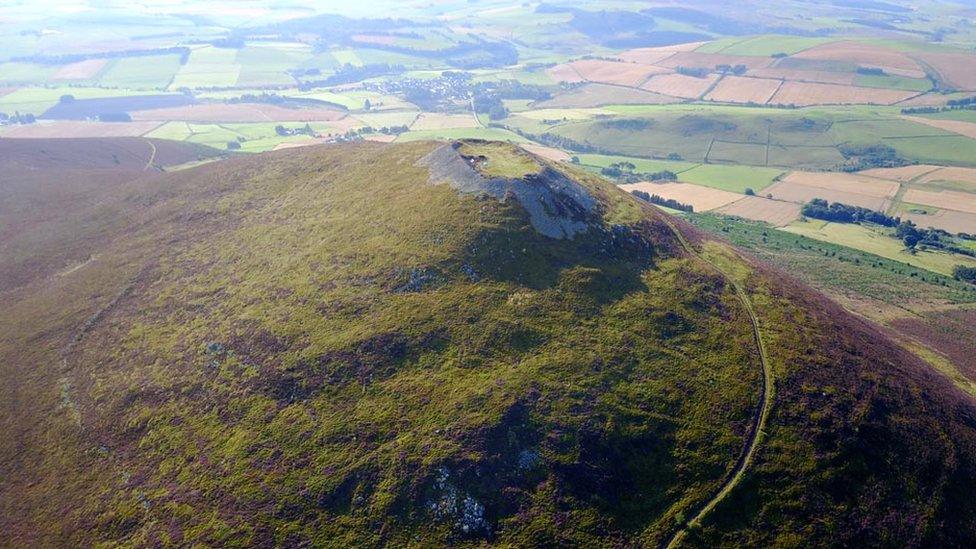Archaeologists dig into Eildon hillfort's secrets
- Published
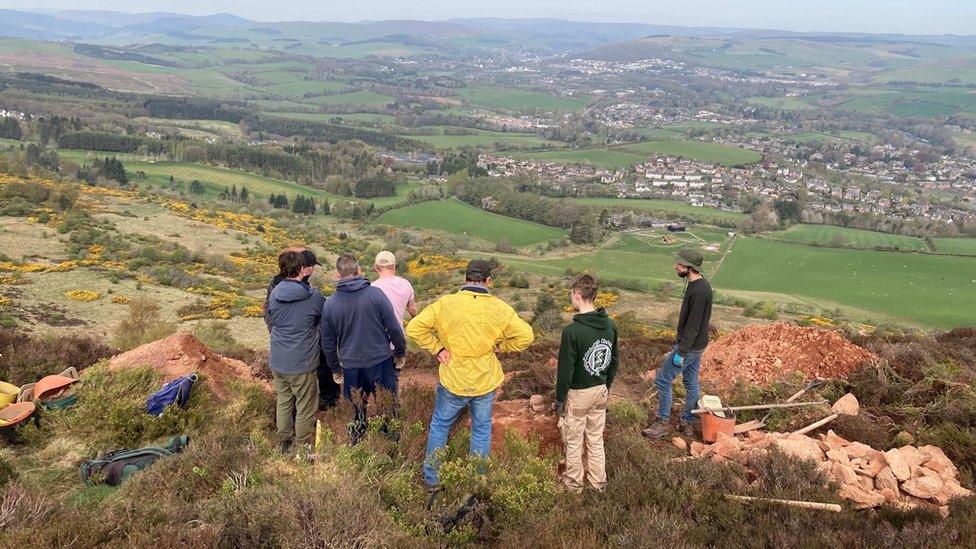
Archaeologists hope to discover more about the story of Eildon Hill North
Some of the country's leading archaeologists have spent the week on top of one of the south of Scotland's most iconic hills.
Finds and dating samples from Eildon Hill North could help rewrite history by proving knights from King Arthur's era were still calling the hillfort their home.
Historians have believed for centuries that the numerous hillforts across southern Scotland were deserted by native tribes when the Romans came marching through the Cheviots in about 73AD.
Eildon Hill North, near Melrose, was the largest hillfort in northern Britain, covering more than 18 hectares with 530 roundhouses and a population of up to 4,000 people
Previous studies have placed occupation from the early Bronze Age (circa 2,500 BC to 800 BC) to the late Iron Age (circa 100 AD to 400 AD), when it was used as a Roman signal station.
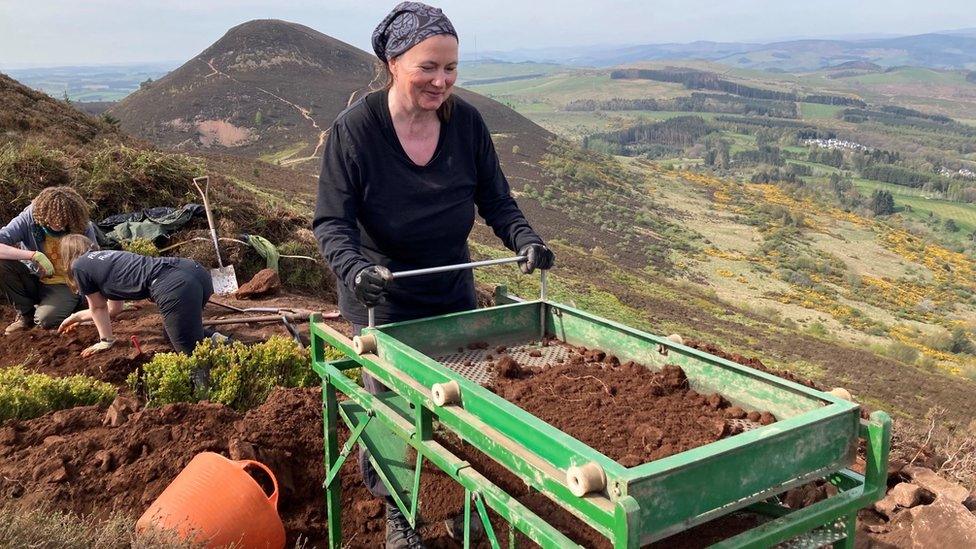
The site in southern Scotland may have been occupied much later than previously thought
Past excavations have found native Bronze Age artefacts and Roman pottery mixed together in the core of the once vast ramparts, which has led to varying interpretations of when developments at the hill fort were made.
Roundhouse platforms have shown usage in both the Bronze Age and Roman Iron Age.
This latest study could override previous thinking, with the view that Eildon Hill North was expanded and fortified either during or after the Romans' occupation of the nearby Trimontium fort.
A similar study by the University of Aberdeen team at Tap O' Noth, near Huntly, found evidence that the hill fort was of the early Medieval period (after 500 AD), rather than the earlier Bronze Age or Iron Age.
Lead archaeologists on Eildon Hill North believe their carbon data samples will return similar results.

Prof Gordon Noble says the hillfort could date to the early Medieval period
Professor Gordon Noble from the University of Aberdeen said: "The traditional assumption was that this is a late Bronze Age site, going back 3,000 to 3,500 years.
"But we've been working in Aberdeenshire on a very similar site, where it was again assumed to be late Bronze Age, but our dating shows that it actually dates to the Roman Iron Age and into the early Medieval period.
"We believe Eildon Hill North is a very close parallel, and it is distinctly possible that the defences here actually date to the same late Roman Iron Age through to early Medieval period.
"If this is the case it would be a real revolution in our understanding of the fort and its wider context."
The Eildon North hillfort study is part of a wider project focusing on the post-Roman early Medieval kingdoms of Scotland and Ireland.

Dr James O'Driscoll said they were now "falling over" themselves with information from the early Medieval period
Dr James O'Driscoll from the University of Aberdeen said: "We've now established that Tap O' Noth dates from Roman Iron Age into early Medieval and if this is also the case here at Eildon Hill North, we are quickly going from having hardly any sites from the early Medieval period to having some of the largest monuments in the country from that period.
"We, as archaeologists, are going from almost being blind about the early Medieval period to falling over ourselves with information."
Part of this week's study is to also determine if Eildon Hill North was in use while the Romans occupied the Trimontium fort just a couple of miles away.
Earlier excavations have determined that a Roman signal station was built on the summit of Eildon Hill North.
But it remains unclear if the majority of the hundreds of roundhouses were built before, during or after the tower was in use.
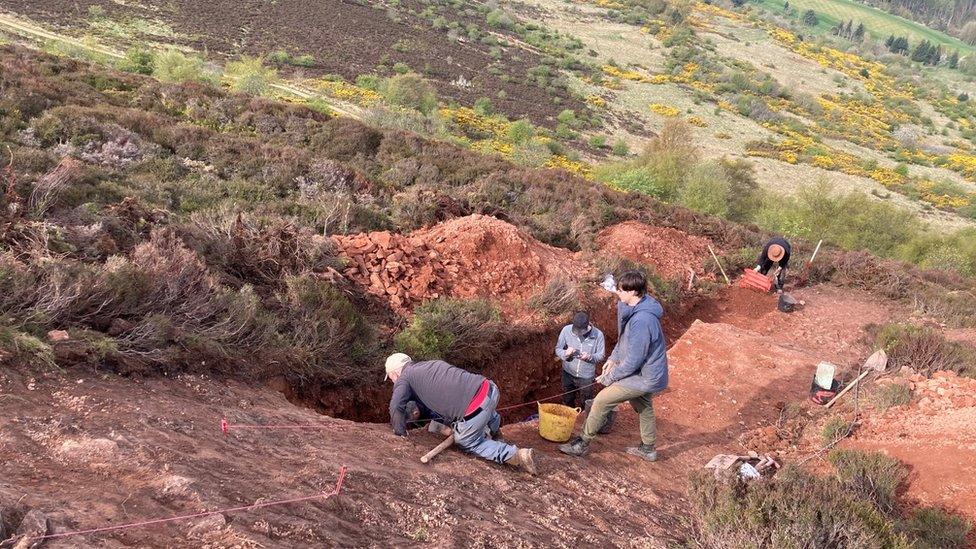
Detailed excavations have been undertaken at the location in the Scottish Borders
Dr O'Driscoll added: "There is a massive settlement up here and we hope to be able to establish if it was contemporary to the Roman fort down at Newstead or if it came immediately afterwards.
"We hope to be able to establish if there were was co-operation between the natives and the Romans."
Evidence gathered at Eildon Hill North hopes to help bridge the gap between the Roman occupation and early historic fortifications which emerged during the later Medieval period.
Historians have mostly worked from limited archaeology and even more limited historical records to attempt to understand a period which spawned legends such as King Arthur fighting the invading Germanic tribes.
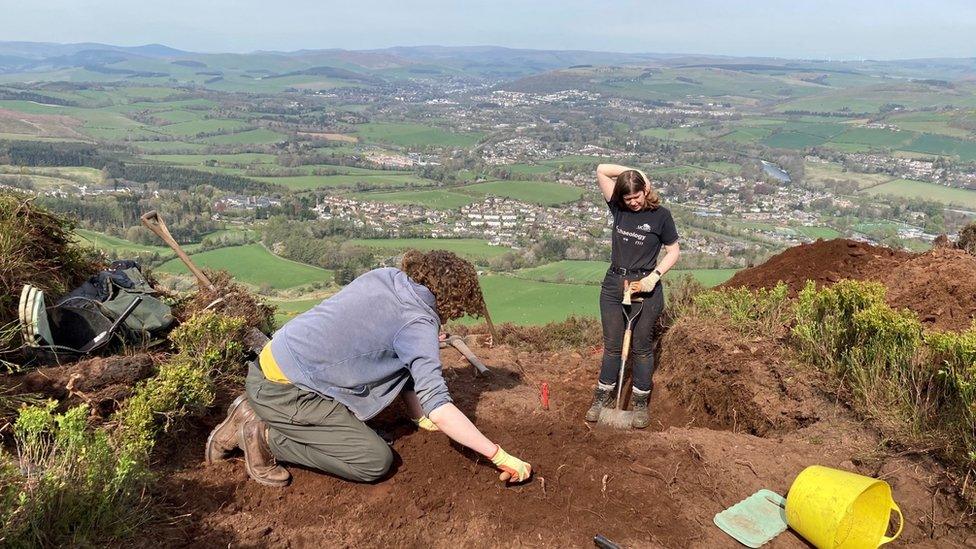
Results from the dig are expected to be published before the end of the year
Local folklorists have long maintained Camelot was in the Borders with Arthur buried deep beneath the Eildons.
Although the team from the University of Aberdeen would not be drawn into the Arthurian arguments, they do hope to provide some solid evidence dating from the period.
Prof Noble added: "Everywhere seems to lay claim to King Arthur and we'll let them all speculate.
"For us it would be amazing to pin down dates for Eildon Hill North - whether it is in fact a late Bronze Age tribal centre, or whether it is a late Roman Iron Age and early Medieval centre."
Results from this week's surveys and digs are expected to be published before the end of the year.
Related topics
- Published14 May 2020
